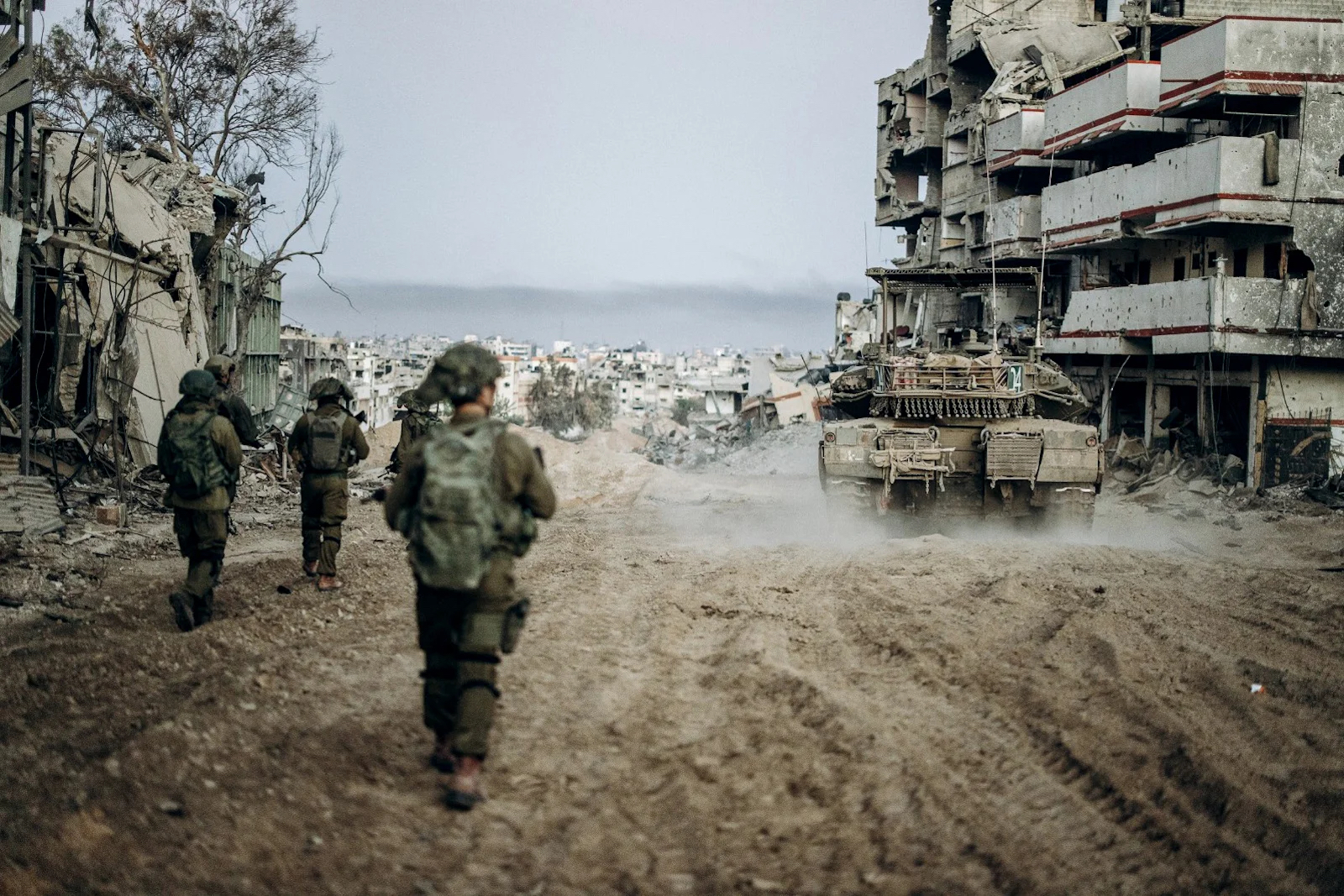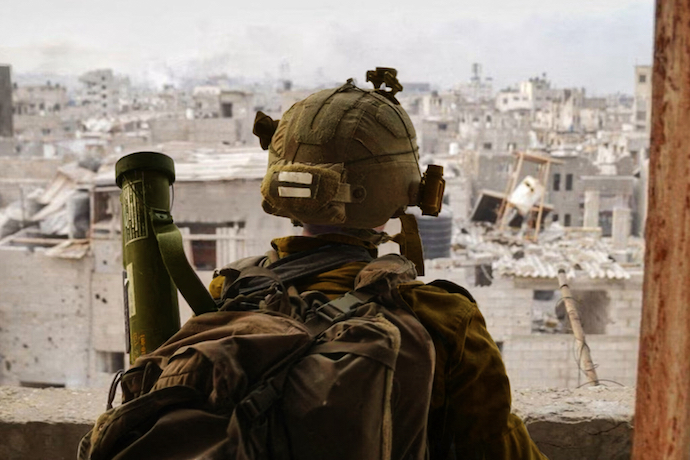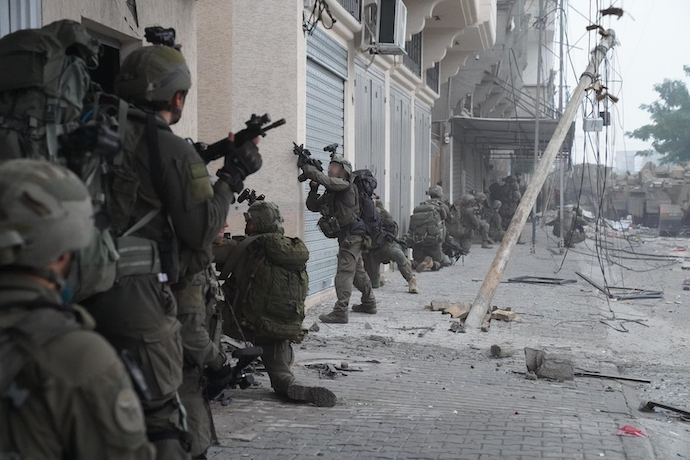
Allied Imperatives in World War II: A Guide for Israel’s War against Hamas
Israel’s prosecution of its war against Hamas is rooted in the Casablanca Conference, otherwise known as the ANFA Conference, of January 1943, which promulgated the Allied commitment to the unconditional surrender of the Axis powers, the application of a lesson learned from the conclusion of the First World War. The fact that Germany did not surrender unconditionally was an enabling factor for Nazi Germany’s rise as a military power. Israel has taken note of this lesson; it has acted upon it.
World War I, except for the Battle of Tannenberg in August 1914, had not taken place on German soil. Save for the Ruhr region, Allied troops did not occupy Germany; the overwhelming majority of Germans had not personally seen an Allied soldier in the country. Consequently, Germany became a fertile environment for the propagation of the belief that Germany was never defeated but stabbed in the back. A reluctance to enforce all of the terms of the Treaty of Versailles allowed Germany to rebuild its armed forces far in excess of the limits imposed by the treaty. Similarly, the unopposed German occupation of the Rhine Valley gave further credence to the opinion that the Allies never defeated Germany.

The insistence on unconditional surrender was deemed necessary so that the citizens of each Axis state would see that their armed forces had been defeated and that their leaders had capitulated. Their armed forces had broken the social contract of the armed forces in any society: a society concedes rights and privileges to the armed forces, which, in turn, protects the civilian population. The failure to do so violates that compact and discredits the armed forces. For the Allies, the war needed to continue on the territory of the Axis powers until they had surrendered unconditionally.
As for any yet undefeated state, it would know what awaited it as long as it did not surrender, and that the civilian population would bear the burden of the intransigence of its leaders. The postwar ruins in Germany, Italy, and Japan, some of which are still visible today, give witness to this strategy. In the cases of Germany and Japan, their military capacity was destroyed. Whereas, Italy joined the Allies in September of 1943, declared war the following month, and maintained its defense forces. History bore out the Allied agreement at Casablanca. Israel seeks a similar unconditional surrender in the present war against Hamas, which is but the latest in a series of conflicts that date back to even before Hamas took power in Gaza in 2006.
In 2006, a disgruntled public, chafing under the corrupt and incompetent governance of the Palestinian Authority, voted for Hamas. Regardless of the motivations of its constituency, whilst no longer fettered by conflict with its internal rival, Hamas made the Gaza Strip the base for its proclaimed permanent jihadist war against Israel. Until October 7, Hamas had followed a pattern of harassing Israel with rocket attacks and kidnappings with enough force to provoke military responses in order to expose Israel to international reproach and court international support.
Although each conflict had ended with heavy casualties in Gaza, this is what Hamas had sought to reap. Hamas constructed warrens of between 350 to 450 miles of tunnels connecting underground facilities replete with legitimate military targets below and close to residences, hospitals, schools, and mosques. No matter the amount of civilian casualties, Hamas, with between 20,000 and 40,000 fighters, would claim victory through survival and always renewed its attacks on Israel.

As stated by politburo member Ghazi Hamad, Hamas sees itself as “a nation of martyrs and proud to sacrifice as martyrs” in a conflict of decades, if not centuries. In a marked shift in tactics, Hamas escalated its offensive posture significantly last year. The militant group launched an estimated 3,000 to 5,000 rockets within a twenty-minute window, and initiated attacks from land, sea, and air—including the deployment of paragliders, and slew 1,200 Jews at a music festival, more Jews than had been killed on any one day since the Holocaust, and took over 240 hostages. Likewise, Israel’s response changed considerably. Drawing a parallel with the Allied position articulated in Casablanca during World War II, Israel contends that only the absolute defeat and unconditional surrender of Hamas is the only way to eliminate Hamas’s capacity to threaten the lives of Israelis.
Israel recognizes that Hamas is an effective force with a disciplined chain of command committed to the destruction of Israel and that no amount of suffering of the people whom Hamas governs has bearing on its actions. Hence, Israel is the only force that can curb Hamas. Although Hamas may act as a satrapy of Iran, a beneficiary of Qatar’s largess, and a recipient of support from other sources, it could be argued that such groups may influence Hamas’s behavior. In the case of Iran, as Hamas is a Sunni client, Hamas is indeed more expendable than its Shiite clients, chiefly Hezbollah of Lebanon, and the Houthis of Yemen. Similarly, just as Iran and Israel seek to avoid direct conflict, Israel is unlikely to apply direct pressure on Iran to influence Hamas. Only the destruction of Hamas will put an end to its means to make war against Israel and to kill Israelis.
Hamas is committed to defending its extensive underground facilities, which were built only for waging war on Israel. Without this system, Hamas never could have been as effective as a fighting force. For years, Hamas has used this system to imprison hostages, protect its leadership, and transport its fighters and weapons. Presently, Hamas retains its capacity to launch rockets at Israel and does so as the system remains mostly intact. Although exercising caution to avoid excess civilian deaths, Israel has eschewed not from strikes on tunnels and their points of access in residential areas. Consequently, Israel will continue this policy to destroy Hamas’s capacity to wage war until such time that Hamas surrenders and the Israeli military may have free access to the underground network to destroy it.
Israel’s goal of unconditional surrender is guided by its vision of an order of post-war security. The unconditional surrender of Hamas will deprive Hamas and its supporters elsewhere of claiming victory through survival, as both groups see this war as a momentary episode in a conflict of decades or even centuries, as witnessed by their frequent comparison of Israel to the Crusader states in the history of Islam in the Middle East. Likewise, for Israel, the pursuit of unconditional surrender is mandatory for Hamas to be seen as vanquished and humiliated in the eyes of the populace of the Gaza Strip, as well as by the rest of Israel’s detractors.
Hamas will have failed to protect its own people, despite what Hamas may say, is the most basic duty of any fighting force. Hamas’s commander in the Gaza Strip, Yahya Sinwar, makes this imperative more compelling. Sinwar spent 22 years in Israeli prisons before his release in exchange for hostages held by Hamas. Amongst the offenses for which he was convicted, Sinwar murdered four Palestinian Arabs whom he had suspected of collaboration with Israel. For Israel, Hamas’s unconditional surrender is necessary lest Palestinians take hold of any belief that Hamas was never defeated but was stabbed in the back.
The reason for unconditional surrender stops not with subduing Hamas. The Allies saw the unconditional surrender of an Axis power as a warning to the others. Israel has no illusions about peace in the immediate future. Israel’s military actions are guided by a strategy to show its opponents, in particular Hezbollah, the cost that they and their noncombatants will bear for threatening the security regime to be established upon Israel’s defeat of Hamas.
